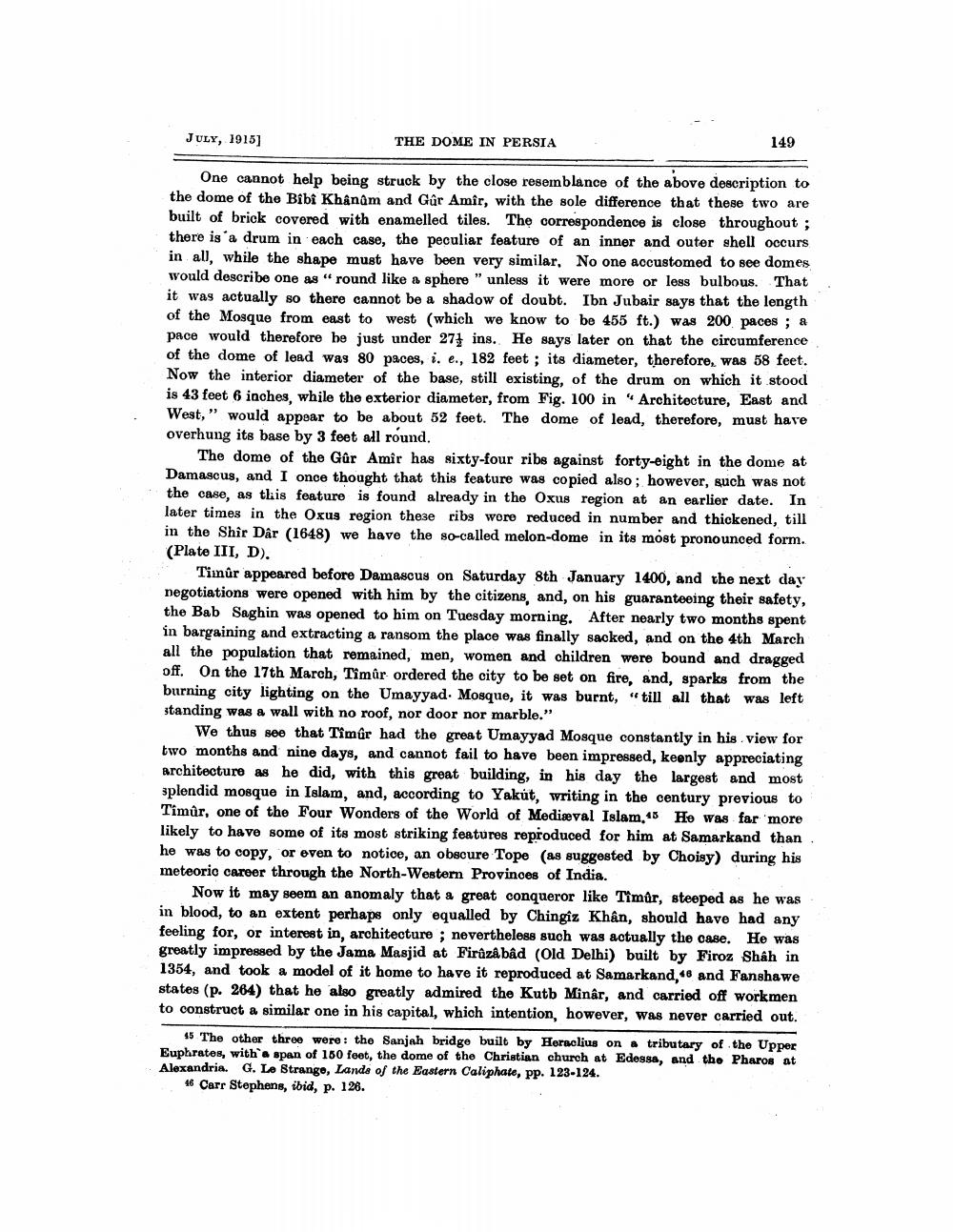________________
JULY, 1915]
THE DOME IN PERSIA
149
One cannot help being struck by the close resemblance of the above description to the dome of the Bibi Khânâm and Gûr Amir, with the sole difference that these two are built of brick covered with enamelled tiles. The correspondence is close throughout; there is a drum in each case, the peculiar feature of an inner and outer shell occurs in all, while the shape must have been very similar, No one accustomed to see domes would describe one as "round like a sphere " unless it were more or less bulbous. That it was actually so there cannot be a shadow of doubt. Ibn Jubair says that the length of the Mosque from east to west (which we know to be 455 ft.) was 200 paces; a pace would therefore he just under 27 ins. He says later on that the circumference of the dome of lead was 80 paces, i. e., 182 feet; its diameter, therefore, was 58 feet. Now the interior diameter of the base, still existing, of the drum on which it stood is 43 feet 6 inches, while the exterior diameter, from Fig. 100 in "Architecture, East and West," would appear to be about 52 feet. The dome of lead, therefore, must have overhung its base by 3 feet all round.
The dome of the Gûr Amir has sixty-four ribs against forty-eight in the dome at Damascus, and I once thought that this feature was copied also; however, such was not the case, as this feature is found already in the Oxus region at an earlier date. In later times in the Oxus region these ribs wore reduced in number and thickened, till in the Shir Dâr (1648) we have the so-called melon-dome in its most pronounced form. (Plate III, D).
Timûr appeared before Damascus on Saturday 8th January 1400, and the next day negotiations were opened with him by the citizens, and, on his guaranteeing their safety, the Bab Saghin was opened to him on Tuesday morning. After nearly two months spent in bargaining and extracting a ransom the place was finally sacked, and on the 4th March all the population that remained, men, women and children were bound and dragged off. On the 17th March, Timûr ordered the city to be set on fire, and, sparks from the burning city lighting on the Umayyad Mosque, it was burnt, "till all that was left standing was a wall with no roof, nor door nor marble."
We thus see that Timûr had the great Umayyad Mosque constantly in his view for two months and nine days, and cannot fail to have been impressed, keenly appreciating architecture as he did, with this great building, in his day the largest and most splendid mosque in Islam, and, according to Yakút, writing in the century previous to Timûr, one of the Four Wonders of the World of Medieval Islam,45 He was far more likely to have some of its most striking features reproduced for him at Samarkand than he was to copy, or even to notice, an obscure Tope (as suggested by Choisy) during his meteoric career through the North-Western Provinces of India.
Now it may seem an anomaly that a great conqueror like Timûr, steeped as he was in blood, to an extent perhaps only equalled by Chingiz Khân, should have had any feeling for, or interest in, architecture; nevertheless such was actually the case. He was greatly impressed by the Jama Masjid at Firâzâbâd (Old Delhi) built by Firoz Shah in 1354, and took a model of it home to have it reproduced at Samarkand,46 and Fanshawe states (p. 264) that he also greatly admired the Kutb Minâr, and carried off workmen to construct a similar one in his capital, which intention, however, was never carried out.
45 The other three were: the Sanjah bridge built by Heraclius on a tributary of the Upper Euphrates, with a span of 150 feet, the dome of the Christian church at Edessa, and the Pharos at Alexandria. G. Le Strange, Lands of the Eastern Caliphate, pp. 123-124.
46 Carr Stephens, ibid, p. 128.




